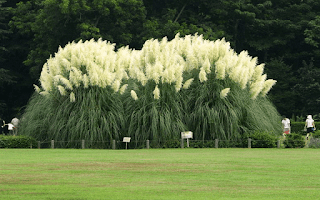A magnificent, large-scale grass, the grass of the pampas, adorns with its wavy presence and feathery inflorescences the center of a lawn or an open corner of the garden. Let's see how to maintain it so that it remains splendid for many years.
Get to know the pampas grass better
Cortaderia selloana, better known as 'Pampa Grass', is a large grass native to the temperate zones of South America. The plant can reach nearly 3 meters in height. It forms a large clump of about 2 meters spreading with linear leaves, thin, green slightly arched and sharp edges.
At the end of the summer silver feathery inflorescences, gradually tingling with pink or purple, emerge from the center of the tuft. They continue long months floating gracefully in the air.
How to maintain the grass of the pampas?
Once properly installed this sturdy plant does not need any watering or fertilizer. Only a few large operations will serve to make it look good.
Bring sharp pruning shears and protect yourself with gloves so you do not cut yourself with the leaves.
In early winter, cut the flower stalks at their base, you can keep them in dry bunches. To do this, dry the head upside down and spray them with hairspray.
Then remove all the faded leaves, then cut the leaves that you estimate in excess to maintain a beautiful silhouette to the plant;
If you live in a cool area, tie the leaves together to form a straight tuft so you can easily cover it with a wintering veil or make a coat around it with dry dead leaves. This one will then be maintained by a fence placed all around the plant.
In spring it will be enough to remove the protections so that your plant regains all its vigor!
Tip: in the sweetest areas like the south of France or the Breton coast, no need for protection.
The grass of the pampas, invasive plant
The purple pampas grass is considered an invasive species; It has established itself in many regions thanks to its exceptional adaptability and its particularly efficient reproduction. Indeed, a single plant can disseminate seeds over a radius of 25 km. It monopolizes the site and captures light and nutrients to the detriment of species already present. Some municipalities of Morbihan, Finistere or Ile and Vilaine are trying to destroy it. It is the pure and hard pulling of the plant and its roots then the sheeting of the zone so that residues of roots do not develop.
The size of the inflorescences is a gentler way of fighting, but only against the spread of the species. The flower stems will be cut off as soon as they develop before they have time to go to seed.
Did you know?
A large tuft of purple pampas grass from the pampas can serve as a refuge for many animals, including hedgehogs. Go easy on size operations and do not put fire especially as it is sometimes recommended!

No comments:
Post a Comment